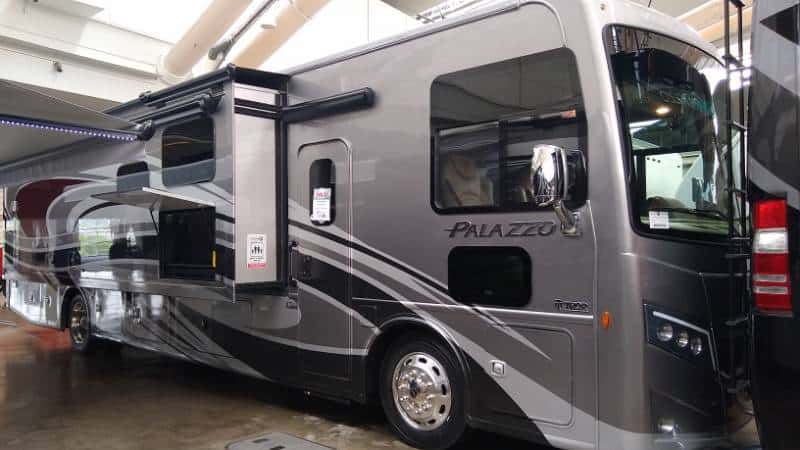In a previous article about why motorhomes don’t have MPG ratings, I gave you a few tips how to calculate your own fuel efficiency and how to improve it. This is a quick follow-up about some of the physics behind the fuel efficiency of an RV. If you’re shopping around for full-time traveling, you might find these thoughts useful.
Total Weight: Not as Important As You Think
Although weight is number one on this list, it’s actually not the number one factor impacting gas mileage.
You know what’s freakishly heavy? An airplane. Do you know what’s incredibly aerodynamic? Also an airplane.
So yes, ceteris paribus, more weight = lower fuel economy. But that’s only true as a broad stroke. Yes, flat-towing a toad will reduce your mpg. But don’t assume a 21,000-lb motorhome consumes less fuel than an 18,000-lb motorhome.
In fact, I think Reason #2 on this list is a bigger factor. My main concern with weight would be RV driving license restrictions. If you’re adding cargo weight to your RV, I’d be more concerned about overloading your capacity before I worried about mpg.
Frontal Area: The Secret MPG Killer

The frontal area is the surface defined by the width and height of your RV. It’s the part of your RV that has to slice through the air.
I use the word “slice” optimistically. Brick-shaped RVs don’t slice; they bludgeon. Air doesn’t like being bludgeoned, so it pushes back, and that creates back pressure that reduces fuel efficiency. Imagine dragging an open parachute behind your tow vehicle. It’s lightweight, but it sure would slow you down!
That’s why, to be honest, finding an aerodynamic RV is kind of a lost cause. They aren’t tested for aerodynamics. They’re all shaped like bricks, and the cab-over designs of Class Cs and 5th wheels are even worse.
But if you’re bound and determined, look for RVs with enclosed underbellys and rounded front and rear corners. Consider a Super C instead of a Class A; consider a streamlined Class B van instead of an obese Class C cruiser.
Wind Speed: The Factor You CAN Control!
If you squint really hard, you might remember high school physics class where you learned that the force of wind is proportional to the square of the velocity. In other words, wind becomes exponentially stronger as it gets faster.
Your RV has the shape and aerodynamic efficiency of a brick. Even “slippery” teardrop-shaped RVs have entry handles, awnings, air conditioners, satellite dishes, lights, ladders, fans, and sewer valves sticking out like so many pins and needles. These components create tremendous drag, regardless of the shape of the RV’s main body.
You can reduce the relative wind speed by driving more slowly. Above 50 mph, fuel economy jumps off a bridge. Don’t just drive 50 mph in front of me on a 2-lane highway, willya?
Grade: Go Downhill!

Any time you brake, you’re wasting energy. You’re converting useful forward motion into useless heat. And that goes for engine braking, too. Friction is still friction. Stick to the flats if you’re concerned about mpg.
Unfortunately, there’s not much you can do about topography. Hills are hills. (If you’re a super nerd, you can read an almost incomprehensible physics-babble discussion at Stack Exchange about whether a car can theoretically achieve better fuel efficiency on hills vs the flats. But for us mere mortals, flat will always be more efficient.)
(If you are said super-nerd, you can even read a whitepaper from the National Renewable Energy Laboratory about the impact of road grade on fuel efficiency. When the road grade increases up to 6 percent – a common mountain road grade – mpg can fall by 30 percent!)
Power-to-Weight Ratio: Where Bigger Is Better
I hesitated to include power-to-weight ratio as a fuel economy factor. I don’t want you to assume it’s more important than what it is. The power-to-weight ratio is a useful concept. After all, sticking an undersized engine inside a heavyweight RV isn’t going to work out well.
But I caution you not to split hairs. This is a low-resolution concept. Don’t assume because one RV has a higher power-to-weight ratio than another that it automatically has better fuel efficiency. But yes, as a rule, a larger power-to-weight-ratio = less work = less fuel burned.
For reference, let us consider the 2021 Mazda3, a small, sporty hatchback. Not an RV – just a regular passenger car. The EPA fuel economy rating is 28/36 mpg. Wow! Pretty good!
- Horsepower: 155
- Max weight (GVWR): 3,968 lbs
- Power-to-weight ratio: 155/3,968 = 0.039 hp/lb
So at the maximum weight of the Mazda3, each pound must be moved by ~0.04 horsepower. (For reference, a decent cyclist can sustain 0.10 horsepower)
Let’s check out a 2021 Tiffin Allegro Breeze:
- Horsepower: 340
- Weight (GVWR): 25,500
- Power-to-weight ratio: 340/25,500 = 0.013 hp/lb
In case you weren’t paying attention … that zippy little Mazda hatchback has 3x the relative power of a gigundous Tiffin motorhome!
I calculated the power-to-weight-ratio of several other RV models, and here’s what I found.
- Most Class A motorhomes have a power-to-weight ratio of 0.012-0.018 hp/lb
- Most Class C motorhomes have a power-to-weight-ratio of 0.020 – 0.026 hp/lb
- Most Class B motorhomes have a power-to-weight-ratio of 0.018-0.032 hp/lb
Where power-to-weight ratio is defined as peak horsepower/GVWR lbs.
Do Different Brands Offer Better MPG?
Once I put my thinking cap on, these numbers made sense.
After all, there are only a handful of major chassis and engine manufacturers in the country. If you’re building a Class B van, for instance, you’ll most likely either choose the Ram Promaster, Mercedes Sprinter, or Ford Transit platform. And that chassis will only accommodate a few types of engines, all made by major players like Ford, Cummins, Mercedes-Benz or General Motors.
So you aren’t likely to find many MPG outliers. Most manufacturers are working with the same brushes to create different artwork.
Again, these numbers are like parables – they break down if you read too much into them. For instance, some models have relatively low power-to-weight ratios, but that’s because they’re diesel, so they make up for “low” horsepower with tremendous torque. Plus, peak power for a diesel arrives lower in the powerband, so you arrive at peak power much faster.
I couldn’t think of a good way to end this post. 1,000 words later, you’re probably still wondering, “But how do I improve my RV’s mpg?”
And the truth is … it’s a lot easier to make more money to pay for more gas than to significantly improve your motorhome’s fuel efficiency. All I can do is rehash your Dad’s advice: Feather the gas pedal. Drive slow. Enjoy the journey, not just the destination.
Or buy a smaller RV.
Leave a Reply